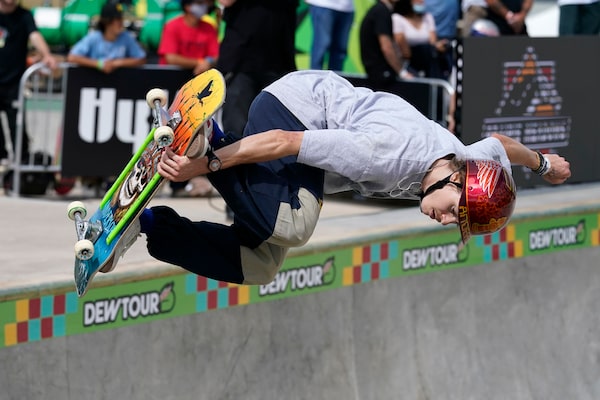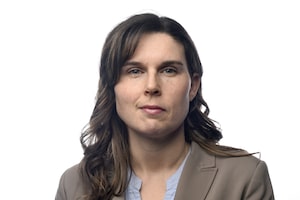
Andy Anderson, of Canada, competes in the Olympic qualifying skateboard event at Lauridsen Skatepark on May 22, 2021, in Des Moines, Iowa.Charlie Neibergall/The Associated Press
When skateboarding makes its debut as an Olympic sport this summer, Canadians will be entertained by Andy Anderson, a professional skater known in the industry for his mesmerizing originality and eclectic skills, making even old tricks look fresh.
The 25-year-old from White Rock, B.C., drives around in an old ambulance that he uses as a camper, performs a trick that is a tribute to a U.S. coach, and challenges the old-school idea that wearing a helmet in the sport is uncool. He wears a helmet to train, compete and most everywhere you see him publicly – even after detractors have urinated in his helmets or run them over with cars.
Anderson, with long golden hair and a wispy moustache, is popular in short YouTube films, skateboarding around the world while stopping to engage with people, animals and nature. He is a freestyle skateboarding world champion, has more than 330,000 Instagram followers, and his own signature skateboard design with manufacturer Powell Peralta. He has started his own helmet company, too, called Mind Control.
Anderson has been in love with the sport since he begged his parents for a skateboard for his fourth birthday after seeing a carefree teenager skateboard down the middle of his street. Today, his skateboard life is nomadic, and he trains in streets and skate parks – usually California or British Columbia – surrounded by skaters of all ages and abilities.
“I remember looking out my livingroom window as a little kid at this guy just pushing with his leg, like it was so awesome,” Anderson said. “I was like, ‘Yeah this guy can play in the street, this guy owns the street’. That got me so excited.”
Anderson is the first and only Canadian skateboarder to meet the Olympic qualifying standard for the park event – set to show off mid-air tricks in the hollowed-out bowl of Tokyo’s Ariake Urban Sports Park. Canada Skateboarding will announce its full Olympic team later this month, including those who qualify for the other discipline there – street.
Mandy Bujold’s chances to compete at Tokyo Olympics face long odds after IOC ruling
Helmets are mandatory only for competitors under 18 in both disciplines, but now also for all competitors in park skateboarding, too.
Only the top 20 men and 20 women in the world rankings qualify for Tokyo in each of the park and street disciplines, with a maximum of three for each country and at least one for each continent. All complex qualifying math aside, Anderson knew he needed a great finish at the Dew Tour in Des Moines, Iowa, last weekend to book his ticket to Tokyo, the last-chance Olympic qualifier for the park event. Yet 10 minutes before his first run, he got injured.
Full of nervous energy, Anderson dropped into the nine-foot deep end of the bowl in practice and fell spectacularly, landing awkwardly on his right leg. He lay there in a twisted painful heap.
“Devastation just poured over me, I could barely walk, but I got up and limped out of the bowl and I could feel the back of my knee swelling up like an elephant’s trunk,” Anderson said. “I was like, ‘I would never, ever, skate in this pain if this last-chance competition wasn’t happening right now’.”
With just minutes until he had to perform, Anderson talked to his coach. The skater walked it off, tried a few simple manoeuvres on his board and tried to scream out the pain. He chose to compete through it, despite limited mobility in the right leg – the one that rides front on his board. He stepped to the lip of the bowl and dove right back in.
Anderson reached deep into his wide-ranging bag of tricks and deviated completely from the run he had planned. That kind of spontaneity is embraced in skateboarding, unlike in some other judged sports, which dictate compulsory moves and scored with rigid point values. The Canadian blocked out the pain and landed every trick in his 40-second run, prompting several loud whoops from the crowd.
He finished fourth and made the semi-finals for the next day. An on-site ultrasound showed a torn meniscus in the knee – but it wasn’t obvious if it was a new or old tear. Regardless, Anderson was determined to compete.
He needed one more great day in the bowl in Des Moines to book his ticket for Tokyo. So he focused on ice baths, rest, physiotherapy, meditation and sitting in high-tech compression pants that speeds leg recovery.
Coach Sean Hayes, whom Anderson hired two years ago to focus on the Olympic dream, was there with him. Hayes, also Canadian, was a skater before turning to coaching and management, where he’s worked with some of the biggest brands and skaters in the sport. While Anderson had incredible talent when they began working together, the skater wasn’t flexible enough to reach his own toes.
Anderson knew little about how to hone his body as a pro athlete. He started doing things that used to be ridiculed in skating circles, such as a lengthy stretching routine and healthy nutrition. For decades, that regime seemed too jock-like and lame in skateboarding, but now most of the elite are putting that effort into their minds and bodies.
“I kept thinking, ‘Yesterday was for nothing if today doesn’t go well,’” Anderson recalled of his next run. “This was me either making it into the Olympics or not, me trying to slide under the curtain by the skin of my teeth as they’re trying to close the curtain.”
He was nervous. To help calm him, Hayes asked Anderson who he was skating for and got the expected upbeat answer: “For the old ladies and the babies” to make them smile.
So Anderson blocked out the pain and worked to wow the crowd. He included a trick in tribute to Mark Waters, the popular USA Skateboard manager who died last summer of COVID-19. Waters was a friend and often let Anderson crash at his house. One time, Waters suggested Anderson try a faster, higher and more powerful manoeuvre, a combination of tricks skaters know as front-side-airwalk-to-disaster. Anderson now calls it the “watermark.” It felt right to include it on this important day.
“The watermark was actually going to be the hardest trick in the whole run for my knee,” Anderson said. “I was riding across the flat and I was like, ‘I got this, for Mark,’ and that amped me up.”
He had three runs in the semi-final round, and after doing really well on the first one, took it easy on his second two, to preserve his knee as much as possible. Anderson finished 11th, good to book his Olympic spot.
“Andy is so creative and such a fan favourite,” Hayes said. “He was able to work through all this pain, and focus on what he needed to do.”
Anderson is now in the San Diego area, off his skateboard for a few weeks to let his knee recover. “I’m still on Cloud 9” he says, despite getting around with a cane. He’s doing physiotherapy and wearing the compression pants. He said he’s “super confident” it won’t hold him back at the Olympics.
Anderson is highly skilled in the park, street and non-Olympic discipline of freestyle skateboarding, but he felt park would be his best opportunity to show off his talents at the Olympics. Not every skater is pleased to see skateboarding added to a massive and commercial global multisport spectacle such as the Games, but Anderson is firmly among those thrilled to see it showcased before a new audience.
“To see it on such a huge stage is going to be amazing and I want to be out there showing the world what skateboarding means to me,” Anderson said. “I hope it resonates with people like it did with me.”
 Rachel Brady
Rachel Brady